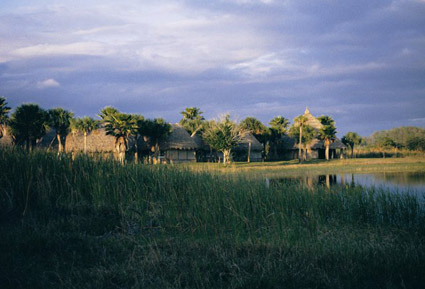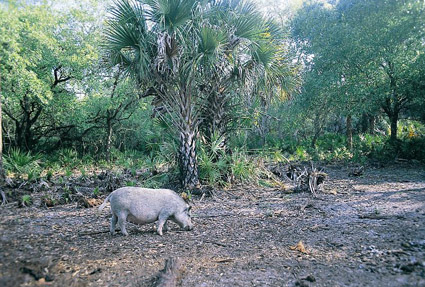<< Previously: Hog Hunting Sensation
 Chickees are dry, clean, and comfortable. A night-in-the-swamp symphony of frogs, feeding gators, and squealing wild hogs provide an evening serenade for guests. |
Now and again we could hear the splash of a gator getting supper, or the squealing and grunting of wild hogs, over the usual nighttime-in-the-swamp sound of groaning frogs, chirping crickets, humming insects, and hooting owls. Seminole Chief James Billie poked at the fire as he spoke.
“When the creator made man and all the animals, they fought one another for supremacy,” he said. “The turkey defeated a Seminole warrior and proudly stuck the warrior’s scalp on the middle of its chest. That is how the turkey got its beard. The turkey is a ‘hot’ animal to the Seminole. He is mystical, and he has a soul. To this day many Seminole will not eat a turkey. But some clans believe it is acceptable to eat a turkey if the hunter places a bay leaf on it and says the proper incantation.”
“And what must the hunter say?” I asked.
Billie leaned over the fire and spoke quietly in Seminole, then translated. “So go away now,” he said. “Cross over. There is nothing for you here.”
I blew out the hurricane lamp, felt my way carefully across the floor of the chickee to the bed, and lay down on top of the covers. The chickee is the traditional thatched-roof dwelling of the Seminole. Though more modern cottages are available for visitors who prefer them, I like the chickees, which I’ve found to be clean, dry, and comfortable.
They’re screened all around to keep out the bugs and let in a breeze. Instead of the industrial whir of air conditioners I fall asleep to the sounds of bullfrogs, fish splashing, wild hogs squealing, the odd, groaning mating call of gators, and occasional other growls and screams the source of which can only be guessed at.
Rattlesnake, Anyone?
We were in the swamp buggy late in the next afternoon, renowned bowhunters Tim Hooey, Brenda Valentine, a Seminole tracker named Ricky, and me. A few hours earlier I had told Brenda how much I coveted a rattlesnake skin to cover a recurve bow. When our guide stopped the swamp buggy to glass a meadow up ahead, I looked down to notice a very large eastern diamondback rattlesnake stretched out across the road in front of us. No sooner did I point it out than Brenda hopped off the swamp buggy and arrowed it, unsheathed her hunting knife, slit the snake up the belly, peeled it like a big banana, and offered me 5 feet of rattlesnake skin.
Subtropical Tracking
Here is a scenario for you: You arrow a good boar, but penetration is lousy. He runs into a patch of cabbage palms several acres in size—the kind of cabbage palms that are about waist-high, forming a canopy over the ground. You can’t see down through them. The only way to track the boar is to crawl under them. Visibility averages about five feet. It’s 90 degrees in the shade, your clothes are plastered to you with sweat, the bugs are driving you insane, the guide keeps reminding you to watch out for pygmy rattlers, and somewhere out there—you can hear him grunting every now and then—is a very angry boar with whom you might at any moment have a very up-close and personal, eye-to-eye kind of encounter.
 At any moment you might have a very up-close and personal, eye-to-eye encounter with an Everglades hog. |
It was almost dusk when we caught up with the boar. Our guide had once again impressed me with his ability to follow flecks of blood the size of a match head over sand, through swamps and wallows, and into the inevitable thicket. Another guide had joined us. At least catching up with the boar and being able to hear his movements—he was still grunting with each step—enabled us to stand up.
We separated in an attempt to encircle the boar, and closed in cautiously. Things began to happen quickly as the boar sensed that he was surrounded. There was a lot of shouting, of rushing forward and retreating just as quickly. One guide carried a handgun and began firing as the boar rushed in his direction, the muzzle flashing brightly in the failing light; the boar turned sharply but kept running.
With darkness fast approaching, I stepped to the edge of the thicket. There was no way I had a shot in there; my only hope was to catch the boar exiting the cabbage palms.
And then, amazingly, he was there, not 15 yards away, standing in the clear. I brought my bow up quickly. One minute before the light was adequate; now it wasn’t. With a wounded target in front of me and nothing to lose, I looked down the shaft and released. The arrow sailed over the boar’s back, the boar squealed and ran off into the darkness, and I nearly wept.
We’d been tracking this boar on hands and knees for most of the day under the blazing subtropical sun. We were spent. We made our way back to the swamp buggy and headed back to camp for a late, cold dinner and the knowledge that in the morning we’d take up the trail again.
We never recovered the boar we tracked in the cabbage palms.
Only a hunter really understands the nagging feelings of remorse and self-doubt that inevitably follow a failure to recover. My only consolation was that we had made a determined effort to track the boar down and finish the job.
I don’t know how many times I have flown into Florida for days spent playing in the sand and surf and evenings dining on seafood in air-conditioned comfort. The next time I do that in Florida, though, I suspect I’ll find myself preoccupied not with the view of the sea but with another world, inland, of tall grass and cabbage palms and cypress trees, gators and rattlesnakes, black bears, Florida panthers, turkeys, and wild boar.






